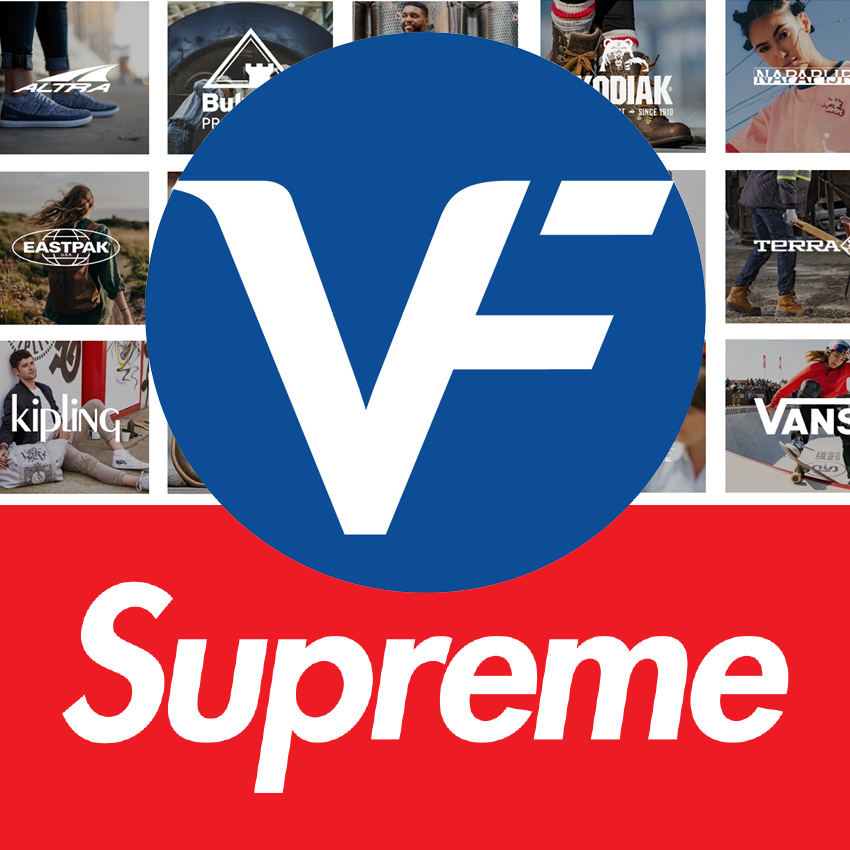We didn\’t honor VF Corporation as a Robin Report 2020 Retail Radical of The Year for nothing. You can read all about it here. Radical is not a hyperbolic description, because what VF and their brands do in reality, with year-over-year regularity, is…well…supreme.
Supreme\’s Next Chapter
I\’m not trying to be cute. I just couldn\’t pass the prescience of VF\’s supreme move of acquiring the Supreme brand, which indeed has had a supreme position since its inception in 1994 within the streetwear culture (AKA gorpcore as of a minute ago).
For $2.1 billion, VF is street smart with tucking this hot brand into its roughly $12 billion portfolio of other hot brands and not messing around with it. VF\’s model allows autonomy for its stable of brands to run all aspects of their business that interface with the consumer, while VF supports and leverages any back end business and operational functions that can add value and synergy to the brands\’ front-end efforts. It\’s working, and The North Face, Vans, Timberland, JanSport and a slew of others continue in rapid growth mode (pandemic aside) within VF\’s strategic and structural model.
Untouchable
In an interview with WWD, VF Corporation CEO Steve Rendle said, \”We understand the skill set that sits inside that (Supreme) team. We don\’t want to disrupt this business. This business is really well run. It always makes me chuckle if people think we\’re going to come in and change Supreme.
[callout]There are many examples of brands under public ownership that got hot and then became ubiquitous, missed a pivot in trend, lost their original creators and/or finally flamed out. The Gap comes to mind, as does A&F and Juicy Couture.[/callout]
\”This will take time. We talk about a light-touch integration with this business because it\’s very successful, operating at a very high level today. We\’ll take our time to get to know each other. This brand will continue to operate as it always has, we do not look to come in and make any changes. We\’re here to help, support and enable.\”
And CFO Scott Roe reflects on an early meeting with Rendle and James Jebbia (founder of Supreme) describing the \”beautiful, simple machine\” of Supreme. \”They have a deep respect for what we do, and we have a deep respect for what they do,\” Roe said. \”That is the basis of a really productive relationship. We don\’t tell them how to run their business.\” He also hit an important note regarding the future of the brand, \”We don\’t want to mess it up.\”
Jebbia added in a statement: \”We are proud to join VF, a world-class company that is home to great brands we\’ve worked with for years, including The North Face, Vans, and Timberland. This partnership will maintain our unique culture and independence, while allowing us to grow on the same path we\’ve been on since 1994.\”
Match Made in Heaven
Given VF\’s track record over the years, I believe you can take their word for supportive laissez-faire intentions. However, there\’s a tricky balance between getting sucked into the growth momentum of a sizzling hot brand and cooling it down for longer term sustainable growth. This is a critical issue for publicly owned companies that have to face the monster of Wall Street every quarter.
Supreme has 12 stores and 60 percent of their business is online. The key to their success since inception has been designer and founder James Jebbia\’s commitment to scarcity, as well as reasonable and orderly growth. This philosophy has resonated with the zeitgeist of his loyal young streetwear enthusiasts. The brand has been a special, cool and perceived as a great personal \”find\” every time Supreme drops new looks. It also has been highly profitable.
Supreme\’s durable and authentic philosophy; the brand\’s profitable growth and its loyal consumer base, which also aligns with VF\’s other brands, were obviously what caught VF\’s interest.
Beware of the Hot-then-Not Syndrome
There are many examples of brands under public ownership that got hot and then became ubiquitous, missed a pivot in trend, lost their original creators and/or finally flamed out. The Gap comes to mind, as does A&F and Juicy Couture.
There\’s another formula that many believe the first generation of Tommy Hilfiger and Michael Kor\’s brands fell victim to. Using a slang phrase, it\’s a \”pump and dump\” strategy. At the pinnacle of the brand\’s hot meter, investors pump millions of dollars behind a strategy that pushes the brand into every distribution channel, every product category, every price point and everything else that pumps the brand into the hands of as many consumers as possible. And they do it quickly while the brand is still sizzling.
This is a proactive strategy that unfortunately sends the brand into the death spiral of ubiquity, returning millions of dollars to the investors as the stock price soars. At the right moment, typically at the height of the share price, investors dump (sell), their holdings and laugh all the way to the bank.
As I have said many times, ubiquitous fashion is an oxymoron.
Supreme Redefines Cool
I will end by saying that hot is probably not how Supreme\’s cool consumers would define their favorite brand. Supreme redefines cool for a new audience — and has done so for a quarter century. VF is savvy enough within its incredible and winning culture not to mess with the cool factor that has sustained Supreme.




